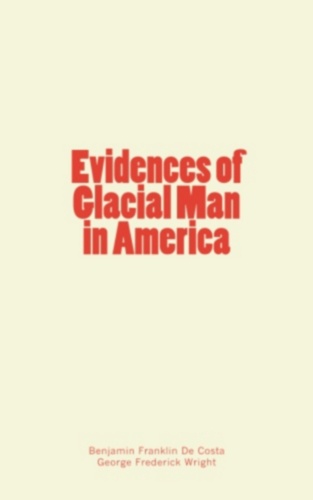En cours de chargement...
In that distant age when Nature was still toiling at the foundations of the Eastern Continent, portions of America had become dry land, and mountain-peaks in North Carolina were illuminated by rising and setting suns. It is, therefore, an anachronism to speak of America as the New World, especially when we remember the high antiquity of the fauna of North America. Still it is believed that the Eastern Continent was the original abode of man.
But when, or under what circumstances, did America receive her first human inhabitant? Heretofore those who have discussed the question have assigned the event to a comparatively modern period, and have considered the probability of immigrations from Asia by Behring Strait; while others have suggested early transatlantic movements, or the peopling of America from a lost continent of the Pacific Ocean.
The discovery of stone implements, however, in the glacial deposits of the Delaware Valley gives a fresh turn to the discussion, and carries the question back to remote periods. It is true that the great antiquity of man on this continent had been maintained previously, but the evidence was quite unlike what is now offered. Yet, whatever may be concluded ultimately respecting the antiquity of the Delaware flints, it is quite apparent that the red-man found in America at the period of its rediscovery by Cabot, Vespucci, and Columbus, was not the descendant of any glacial man.
No line of connection can be made out. This continent does not appear to have any Kent's Hole like that at Torbay, affording a continuous history, beginning with the cave-bear and ending with "W. Hodges, of Ireland, 1688." The race that rose to wealth and power in Central America did not succeed any rude spear-maker. More and more is it becoming evident that the people of Central America sprang from a superior race inhabiting the borders of the Mediterranean.
This is indicated by a certain similarity in manners, customs, architecture, and religion. Investigations, now in progress, promise to yield the approximate date of the period when the first conquerors of Mexico and Yucatan crossed the sea. The Spaniards learned that the people whom they conquered had themselves figured in the rôle of invaders, entering from a country called Tulan or Tulapan, and overrunning the then dominant race.
It may yet be demonstrated that this took place about the third year of the Christian era. But who were these earlier inhabitants? These we believe were not the descendants of an indigenous race, any more than were the later tribes. There is nothing to show that they were ever connected in America with any glacial or pliocene man. They might, however, be referred to still more remote migrations from Europe, which may have taken place in connection with events that gave rise to the story of the lost continent of Atlantis, as related by Plato.
The so-called aboriginal red-man is comparatively a modern, although the author of "Leaves of Grass" asks concerning "the friendly and flowing savage, " is he "waiting for civilization or past it and mastering it?" However this may be, he is wandering over the graves of peoples who left no record of their exploits, either in the continent where they sprung into life or where they died. It is, indeed, a significant fact that the East furnishes no very plain tradition of any exodus which peopled America...


